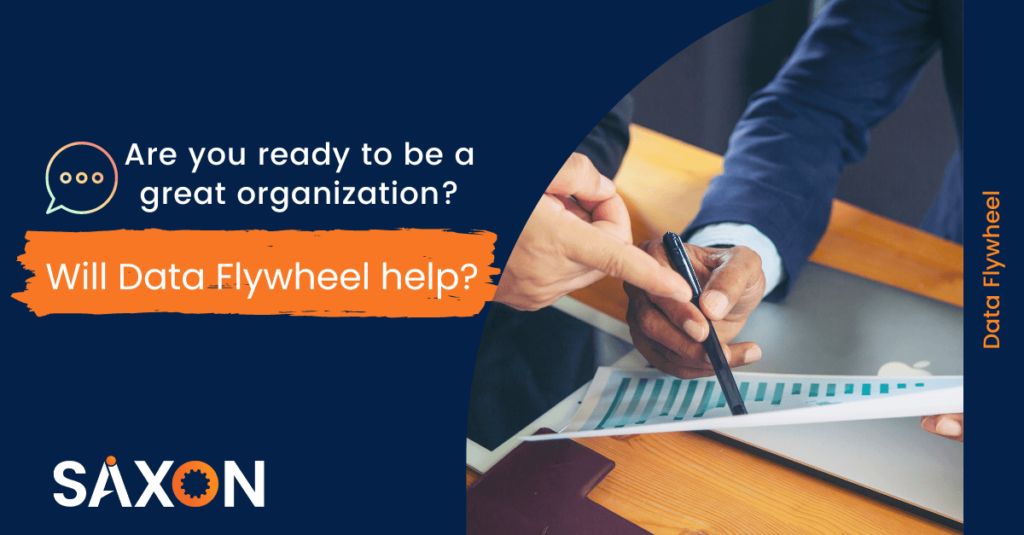In his seminal book “Good to Great,” Jim Collins provides insights and a framework for transforming organizations from good to extraordinary.
A Good to Great transformation looks dramatic to customers and all external stakeholders, but the beginnings almost go unnoticed by the internal stakeholders within organizations. Usually, this process is comparable to cranking a large, heavy flywheel. The initial effort required to start the flywheel and build energy is enormous, but the flywheel builds momentum with consistent efforts in the right direction over a long period. Eventually, it gathers speed achieving breakthrough results, making it impossible to stop.
As enterprises increasingly adopt digital channels to enhance customer experience, organizations that build a data flywheel tend to outdo their competitors.
A data flywheel accelerates the momentum of a product or service through the strategic use of data. It uses the insights to create a virtuous cycle where better data insights lead to faster time to market, better products, and higher customer lifetime value. An effective data flywheel strategy inspires new product/service innovations, increased revenue growth, and higher profits.
Data Flywheel – An Example
A standard or popular example of a data flywheel is the recommendations we all receive on Amazon to buy products or on Netflix to watch content. The data-driven algorithms power the recommendations. The earlier versions of such recommendation engines were simple by showing the high-in-demand products or videos to the audience based on the frequency and count of product purchases or content views. As the product gained higher adoption and better engagement, it developed an inherent capability to feed more data points to the recommendation engine. This further enhanced the efficiency and possibility of providing personalized recommendations to every netizen visiting the website. As customers, we all expect to be treated special, and products/services that can do this reasonably well will win our loyalty. This magic sauce has made Amazon or Netflix hugely successful products. Amazon and data flywheel sync up together to rule the customer behavior analysis.
How does the Concept of a Data Flywheel work?
It begins with a solid foundation for data capture or collation. While there are innumerable ways to gather data from various sources, getting the data in the desired format is always challenging. Every business decision maker demands that the data and information provided according to their business priorities. For example, eCommerce marketers would want real-time access to Sell-Through Rate (STR) data of lookalike products on competing marketplaces. What would be the data points in such cases? They leverage data points such as:
- Seller ratings and reviews
- Dynamic pricing
- Product images, titles, and categories
- Marketplace search engine results
- Special offers
In all this, data collection is the foundation of the data flywheel. Unfortunately, this data collection is too complex and complicated. We can hire DevOps engineers, Data Experts, infrastructure engineers, and developers to build and support systems for collecting operational data, but this is expensive and hard to scale.
Enterprises need a modern data stack that is an automated, agile, and financially viable solution that can streamline data collection. Such solutions should operate on a global scale and be able to access data from any source in any format. It should leverage its technological prowess to circumvent technology blockades. Any tool/service should comply with industry usage guidelines to ensure the data collected will maintain its long-term business value. Additionally, businesses will want to receive data that has already been structured, cleaned, synthesized, and formatted so that its consumption is ready for teams and systems.
Amazon and Data Flywheel
All of us witnessed the potential of data flywheel as consumers of Amazon Prime. As a subscriber of Amazon prime, our transaction data from one service is cross-pollinated to improve our experience with other services, further creating increased engagement and higher wallet share for Amazon. Prime, however, is the initial touch point for Amazon to cross-sell or upsell additional services like music, videos, pantry, etc.
Many of you could have seen that Google may know your intent beforehand from all the data sources we interact with. The assumption for our pizza order with Google Assistant that checks all the data sources may not be a distant reality. Google checking our health records and past orders to customize the menu before we ask for it or reject it based on health data may not be fiction anymore. Data will guide our preferences and set actions for us shortly.
Improving RoI with successful Data Flywheel
A good data flywheel can help enterprises:
- To build an effective real-time feedback loop that incessantly stimulates product/service innovation, thereby creating new market opportunities. Continuous learning and better products can lead to more customers for organizations.
- Lower cost of customer acquisition and improve brand equity. As organizations improve their product/service based on customer feedback and opinion, it fits the market needs and eases customer acquisition. Product companies like Dropbox and Slack exemplify this strategy as they react continuously to customer demands.
- Avoid data risks and enable better regulatory compliance. As compliance requirements like GDPR and HIPAA increase, organizations must allow their data-driven products under these new requirements.
In the past, developing and managing data flywheels was seen as a privilege for a selected few organizations. It is due to costs, availability of technology, and resources. Today with technology vendors like Microsoft, data collection, storage, and analysis at scale in real-time are made available to enterprises of all sizes. One can quickly implement the data flywheel with a strong solutions partner.
Go spin your data flywheel and transform yourselves into a great organization!

